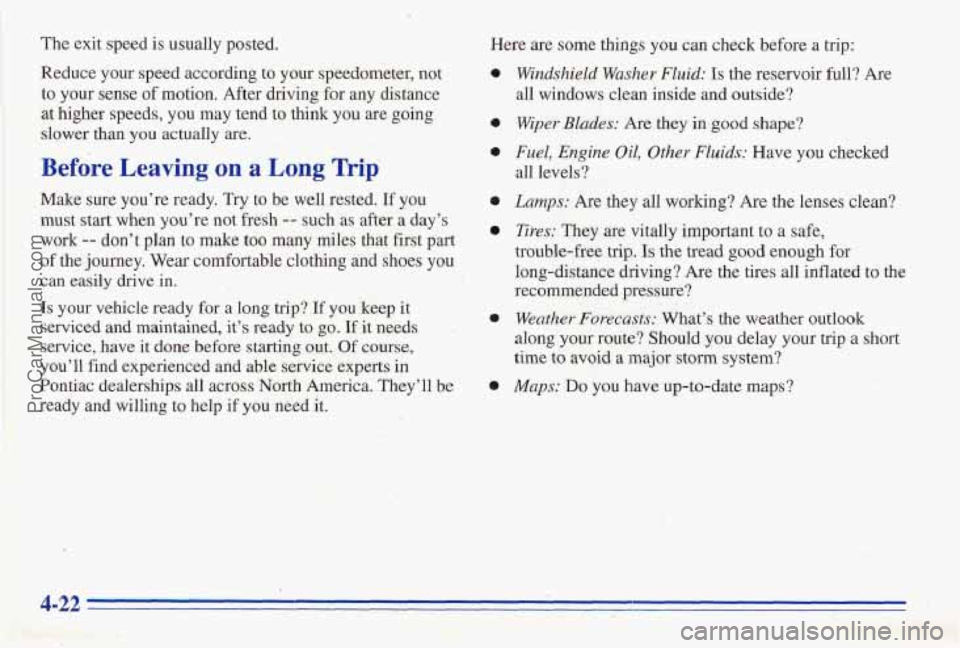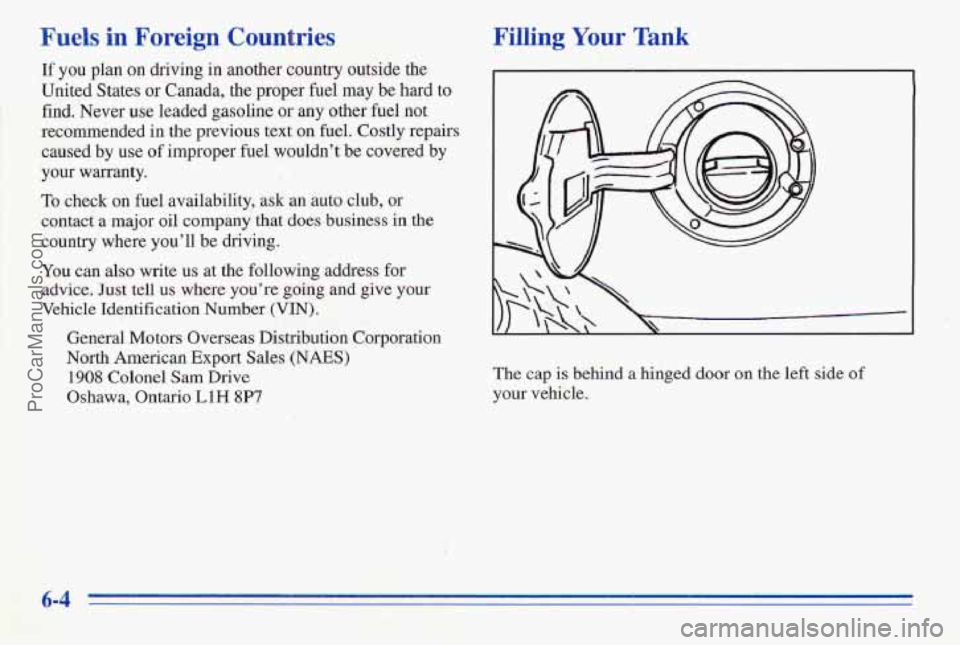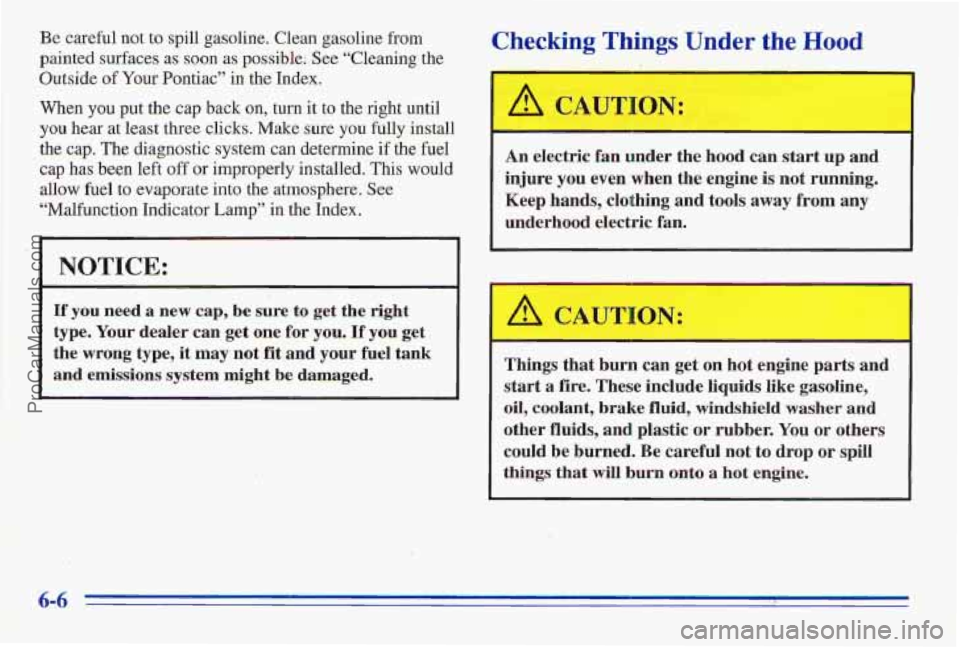check oil PONTIAC FIREBIRD 1996 Owners Manual
[x] Cancel search | Manufacturer: PONTIAC, Model Year: 1996, Model line: FIREBIRD, Model: PONTIAC FIREBIRD 1996Pages: 386, PDF Size: 19.18 MB
Page 134 of 386

Have you recently changed brands of fuel?
If so, be sure to fuel your vehicle with quality fuel (see
“Fuel” in the Index).
Poor fuel quality will cause your
engine not to run as efficiently as designed. You may
notice this as stalling after start-up, stalling when you
put the vehicle into gear, misfiring, hesitation on
acceleration or stumbling on acceleration. (These
conditijons may go away once the engine is warmed up.)
This will be detected by the system and cause
the light
to turn on.
If you experience this condition, change the fuel brand
you use. It will require at least one full tank of the
proper fuel to turn the light
off.
If none of the above steps have made the light turn off,
have your dealer or qualified service center check the
vehicle. Your dealer has
the proper test equipment and
diagnostic tools
to fix any mechanical or electrical
problems that may have developed.
Engine Oil Pressure Gage
This gage tells you if there
could be
a problem with
your engine oil pressure.
The engine oil pressure gage shows the engine oil
pressure in psi (pounds per square inch) in the United
States, or Wa (kilopascals)
in Canada, when the engine
is running. Oil pressure should be 20 to 80 psi (140 to
550 kPa). On the 3800 engine the oil pressure should be
between
20 and 120 psi (140 to 827 kPa). It may vary
with engine speed, outside temperature and oil viscosity,
but readings above the red area show the normal
operating range. Readings in the red area tell
you that
the engine is low on oil, or that you might have some
other oil problem. See “Engine Oil” in the Index.
2-85
ProCarManuals.com
Page 135 of 386

Don’t keep driving if the oil pressure is low. If
you do, your engine can become
so hot that it
catches fire.
You or others could be burned.
Check your
oil as soon as possible and have your
vehicle serviced.
NOTICE:
I
Damage to your engine from neglected oil
problems
can be costly and is not covered by
your warranty.
Low Oil Light
LOW OIL
Your vehicle is equipped with an oil level monitoring
system. When
you start your engine, the waning light
will come
on briefly. If the light doesn’t come on, have
it repaired.
If the light stays on after starting your engine, your
engine oil Level may be too
low. You may need to add
oil.
See “Engine Oil” in the Index.
2-86
ProCarManuals.com
Page 136 of 386

NOTICE:
The oil level monitoring system only checks the oil level when you are starting your engine. It does not
keep monitoring the level once your
engine is running.
Also, the oil level check only
works when the engine has been turned
off long
enough for the oil to drain back into the oil pan.
Check Gages Light
CHECK GAGES
This warning light will
come on briefly when you
are starting the engine. If
the light comes on and stays
on while you are driving,
check your gages to see if
they are
in the warning
areas.
Fuel Gage
Your fuel gage shows about
how much fuel is in your
tank. The gage works only
when the ignition switch is
in the RUN position.
I I
When the gage pointer first indicates EMPTY (E), you
still have a little fuel left (about one to two gallons), but
you need
to get more right away.
Here are four concerns some owners have had about the
fuel gage. All these situations are normal and do not
indicate that anything is wrong with the fuel gage.
At the gas station, the gas pump shuts off before the
It takes more (or less) gas to fill up than the gage
gage
reads
FULL (F).
reads. For example, the gage reads half full, but it took
more (or less) than half of the tank’s capacity to fill it.
a The gage moves a little when you turn, stop or speed up.
When you turn the engine off, the gage doesn’t go
back to EMPTY (E).
2-87
ProCarManuals.com
Page 183 of 386

. 'The exit speed is usually posted.
, . :Reduce your speed according to your speedometer, not
- : .' :to your sense of motion. After driving for any distance
at higher speeds, you may tend to think you. are going
slower than you actually are.
.pg I*:., :.'-L. :.& .-.(,-.r
Be€ore Leaving on a Long nip'* A
Make sure you're ready. Try to be well rested. If you
must start when you're not fresh -- such 'as after a day's
, work -- don't plan to make too many miles that first part
of the journey. Wear comfortable clothing and shoes you
can easily drive in.
Is your vehicle ready for a long trip?' If you keep it
serviced
md maintained, it's ready to go. If it needs L
service, have it done before starting out. Of course,
you'll find experienced and able service experts in
Pontiac dealerships all across
North America. They'll be
ready and willing to help if you need it.
,' <:. 8
Here are some things you can check before a trip:
Windshield Washer Fluid: Is the reservoir full? Are
all windows clean inside and outside?
Wiper Blades: Are they in goo,d shape?
Fuel, Engine Oil, Other Fluids: Have you checked
all levels?
Lamps: Are they all working? Are the lenses clean?
Tires: They are vitally important to a safe,
trouble-free
trip. Is the tread good enough for
long-distance driving?
Are the tires all inflated to the
recommended pressure?
Weather Forecasts: What's the weather outlook
along your route? Should .you delay your trip a short
time to avoid a major storm system?
Maps: Do you have up-to-date maps?
4-22
ProCarManuals.com
Page 197 of 386

Driving with a m +er
Towing a trailer requires a certain amount of experience.
Before setting out for the
open road, you’ll want to get
to know your rig. Acquaint yourself with the feel of
handling and braking with the added weight of the
trailer. And always keep .in mind that the vehicle you are
driving is now a good deal longer and not nearly as
responsive as your vehicle
is by itself.
Before you start, check the trailer hitch and platform
(and attachments), safety chains, electrical connector,
lamps, tires and mirror adjustment. If the trailer has
electric brakes, start your vehicle
and trailer moving and
then apply the trailer brake controller by hand to be sure
the brakes are working. This lets you check your
electrical connection at the same time.
During your trip, check occasionally to be sure that the
load is secure, and that the lamps
and any trailer brakes
are still working.
FoIlowing Distance
Stay at least twice as far behind the vehicle ahead as you
would when driving your vehicle without a trailer. This
can help you avoid situations that require heavy braking
and sudden turns.
Passing
You’ll need more passing distance up ahead when
you’re towing a trailer. And, because you’re a good deal
longer,
you’ll need to go much farther beyond the
passed vehicle before
you can return to your lane.
Backing Up
Hold the bottom of the steering wheel with one hand.
Then, to move the trailer to the left, just move that hand
to the left. To move the trailer to the right, move your
hand to the right. Always back up slowly and,
if
possible, have someone guide you.
Making Turns
NOTICE:
Making very sharp turns while trailering could
cause the trailer to come
in contact with the
vehicle.
Your vehicle coul’d be damaged. Avoid
making very
sharp turns while trailering.
When you’re turning with a trailer, make wider turns than
normal. Do this so your trailer won’t strike soft shoulders,
curbs, road signs, trees or other objects. Avoid jerky or
sudden maneuvers. Signal well in advance.
4-36
ProCarManuals.com
Page 199 of 386

.. ' When You Are Ready to Leave After
Parking on a €Till
' ' 1. Apply your regular brakes and hold the pedal down
while
you:
Start your engine;
Shift into a gear; and
0 Release the parking brake.
2. Let .up on the brake pedal.
3. Drive slowly until the trailer is clear of the chocks.
4. Stop and have someone pick up and store the chocks.
Maintenance When Trailer Towing
Your vehicle will need service more often when you're
pul1ing.a trailer. See
the Maintenance Schedule for more
on this. Things that are especially important in trailer
operation
are automatic: transmission fluid (don't
overfill), engine oil, axle lubricant, belts,
cooling system
and brake adjustment. Each
of these is covered in this
manual, and the Index will heip you find them quickly.
If you're trailering, it's a good idea to review these
sections befcn-e
you start yam trip.
Check;periodically
to see that all hitch nuts and bolts .
are tight.
.. 1
4-38
ProCarManuals.com
Page 216 of 386

Heater and radiator hoses, and other engine
parts, can be very hot. Don’t touch them.
If you
do, you can be burned.
Don’t run the engine if there is a leak.
If you run
the engine, it could lose all coolant. That could
cause
an engine fire, and you could be burned.
Get any leak fixed before you drive the vehicle.
NOTICE:
Engine damage from running your engine
without coolant isn’t covered by your warranty.
If there seems to be no leak, with the engine on, check to
see if the electric engine fan is running. If the engine
is
overheating, the fan should be running. If it isn’t, your
vehicle needs service.
How to Add Coolant to the Coolant
Recovery Tank
If you haven’t found a problem yet, but the coolant level
isn’t at
FULL COLD, add a 50/50 mixture of clean
water
(preferably distilled) and DEX-COOL TM
(orange-colored, silicate-free) antifreeze at the coolant
recovery tank. (See “Engine Coolant” in the Index for
more information.)
I A CAUTION:
Adding only plain water to your cooling system
can be dangerous. Plain water, or some other
liquid like alcohol, can boil before the proper
coolant mix
will. Your vehicle’s coolant warning
system is set for the proper coolant mix. With
plain water or the wrong mix, your engine could
get too hot but you wouldn’t get the overheat
warning. Your engine could catch fire and you or
others could be burned. Use a
50/50 mix of clean
water and
DEX-COOL TM antifreeze.
ProCarManuals.com
Page 245 of 386

Fuels in Foreign Countries
If you plan on driving in another country outside the
United States
or Canada, the proper fuel may be hard to
find. ‘Never use leaded gasoline or any other fuel not
recommended in the previous text
on fuel. Costly repairs
caused by
use of improper fuel wouldn’t be covered by
your warranty.
To check on fuel availability, ask an auto club, or
contact
a major oil company that does business in the
country where you’ll be driving.
You can also write us at the following address for
advice. Just tell
us where you’re going and give your
Vehicle Identification Number
(VIN).
General Motors Overseas Distribution Corporation
North American Export Sales
(NAES)
1908 Colonel Sam Drive
Oshawa, Ontario
L1H 8P7
Filling Your Tank
The cap is behind a hinged door on the left side of
your vehicle.
6-4
ProCarManuals.com
Page 247 of 386

Be careful not to spill gasoline. Clean gasoline from
painted surfaces as soon as possible! See “Cleaning the
Outside
of Your Pontiac” in the Index.
When
you plat the cap back on, turn it to the right until
you hear at least three clicks. Make sure you fully install
the cap. The diagnostic system can determine if the fuel
cap
has been left of or improperly installed. This would
allow fuel to evaporate into
the atmosphere. See
“Malfunction Indicator
Lamp” in the Index.
NOTICE:
If you need a new cap, be sure to get the right
type. Your dealer can get one for you, If you get
the
wrong type, it may not fit and your fuel tank
and emissions system might
be damaged.
.j
Checking Things Und-- the Hoop
An electric fan under the hood can start up and
injure you even when the engine is not running.
Keep hands, clothing and tools away
from any
underhood electric fan.
Things that burn can get on hot engine
parts and
start a fire. These include liquids like gasoline,
oil,
coolant, brake fluid, windshield washer and
other fluids, and plastic or rubber. You or others
could be burned. Be careful not to drop or spill
things
that will burn onto a hot engine.
6-6 .:
ProCarManuals.com
Page 251 of 386

Before closing the hood, be sure all the filler caps are on.
Then just pull the hood down and
close it firmly.
Engine Oil
LOW
OIL
If the LOW OIL light
on the instrument
panel comes on, it
means you need to
check your engine oil
level right away.
5.7L LT1 (Code P) Oil Dipstick
The engine oil dipstick is the yellow
loop near the back
of the engine.
For more information, see
"Low 0il.Light" in the Index.
You
should check your engine oil level regularly; this is
an added reminder.
It's a good idea to check your engine oil every time you
get fuel. In order to get an accurate reading, the oil must
be
warm and'the vehicle must be on level ground.
ProCarManuals.com